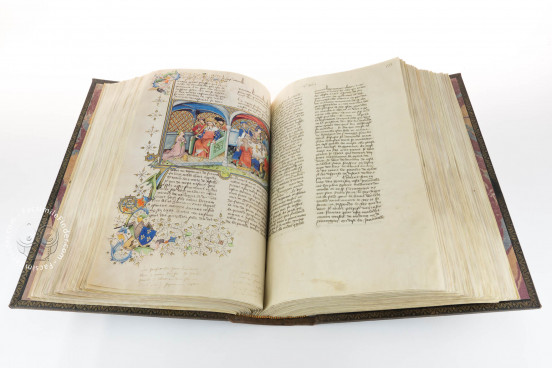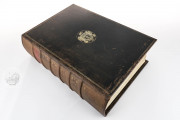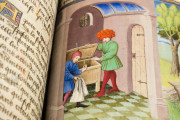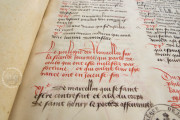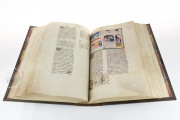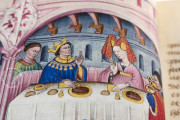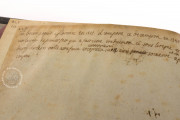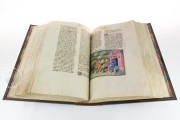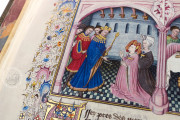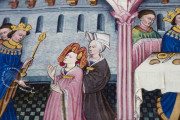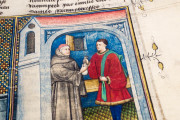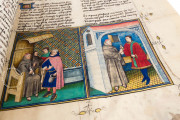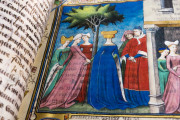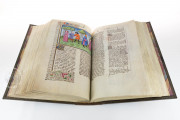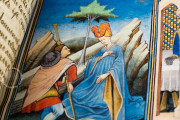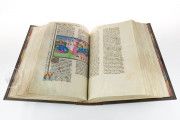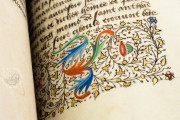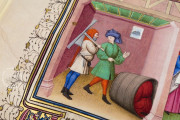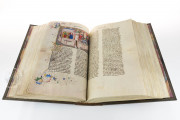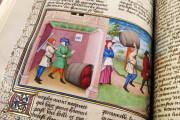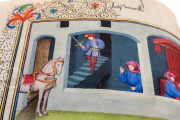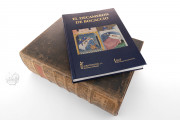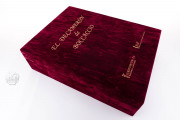The Decameron of Philip the Good, Duke of Burgundy, has a prominent place in the prestigious collection of illustrated medieval manuscripts kept in the Arsenal Library due both to the beauty of its illuminations and its illustrious origins. The manuscript was illustrated in Grammont, France, from 1445 to 1450 by two renowned artists, namely the master of Guillebert de Mets and the master of Mansel, who based their work on a previous volume of Boccaccio’s Decameron, produced in Paris in 1414 by the Master of the “Cité des Dames” and currently known as Palatinus Latinus 1989.
The volume consists of 395 parchment leaves measuring 40 x 28.5 cm, that is, 51 gatherings or quires, held together by an 18th-century blue morocco leather binding and penned in early bâtarde cursive script in French.
The Harmony, Luminosity, and Inventiveness of Two French Masters
The illustrations are very much inspired by a manuscript now kept in the Vatican Library with the shelfmark Palatinus Latinus 1989. It has long been recognized that the illustrations were the combined work of two different workshops: the one known as that of maître de Guillebert de Mets, and that of maître du Mansel.
The master of Guillebert de Mets had been trained in the school of the great Parisian illuminators of the international Gothic style, such as the master of Boucicaut and the master of Egerton. Although he scrupulously followed the model of the Palatinus Latinus 1989, by means of confident drawing, outlined with lead pencil strokes, a real taste for materials, and the sense of the harmony of colors, the master of Guillebert de Mets gave the decor a presence that was not found in his model.
The master of Mansel remodeled the organization of the groups or characters, the alignment of architectural items and often gave the architectural decoration a kind of perspective and realism not found in his model. An atmosphere painter, the master of Mansel excelled in rendering landscapes and skies. By delicate gradations of blue, he gave the skies real luminosity.
The margin decoration, consisting of a half-border decorating the left-hand column of text, is only found on the illustrated pages of a miniature and marks the beginning of each tale. The borders done at the workshop of maître de Guillebert de Mets stand out for their richness and inventiveness, containing humorous drolleries and long lambrequin mantling with very different coloring, pink and blue, of Italian inspiration, and were influenced by the art of maître de Boucicaut.
The ones that came out of the workshop of maître du Mansel are relatively soberer and are reminiscent of the work of Simon Marmion, one of the pupils of the master of Mansel. These are the very fine branches rolled up with threads studded with flowerets, tiny leaves and burnished gold points, accompanied by fine acanthi in bright colors, orange, blue, and green.
A Royal Script
The manuscript was written in full by Guillebert de Mets, copyist and book producer for the Duke of Burgundy, in a remarkable example of early bâtarde cursive script. This book-like script, less ceremonial than the littera formata, originated in the writing of the French royal chancellors, sloping slightly to the right, marked by the contrast of the bold and the lean types and the loops at the top of the letters b, d, l, and h.
From a Duke’s Bookshelf to a National Public Library
One can reasonably give credit to the hypothesis that Guillebert de Mets was commissioned with Arsenal manuscript 5070 from 1435 to 1439, by one of the abbots of Saint-Adrien de Grammont, doubtlessly Adrien Kimpe, then the abbey receiver, to be given to Philip the Good. The work may well have been delivered on the Duke of Burgundy’s visit to the abbey on May 2nd, 1441.
The manuscript became part of the Marquis de Paulmy’s library around 1764, after being handed down to him by his uncle the Count d’Argenson. After the Revolution the Arsenal became a national public library in 1797. Work was begun on the catalog of the collections, among which was the library of the Marquis de Paulmy.
Binding description
The present binding dates back to the 18th century and is thus not the original, but was done when the manuscript became part of the Count d’Argenson’s collection. The original blue morocco leather has turned dark green due to exposure to light and the passing of time.
The very sober decoration includes the Count d’Argenson’s arms and a border of three gilt fillets on the cover boards. The cover edge and the exposed parts of the inner covers are embellished and gilded with a roller. On the first panel, the title (DECAMERON DE BOCACE) appears in gold on a piece of red morocco leather. At the end of the 19th century, copper corner protectors were added to reinforce and safeguard the lower part of the binding.
We have 1 facsimile edition of the manuscript "Paris Decameron": El Decamerón de Boccaccio facsimile edition, published by Scriptorium, 2009
Request Info / Price

